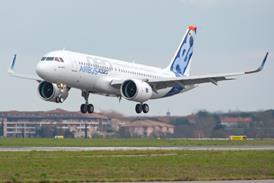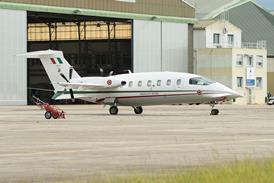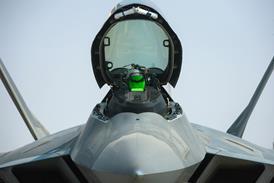PAL's recent history has been a litany of financial disaster. Since 1990 it has amassed more than $300 million in losses against a backdrop of boardroom infighting, ownership wrangles and lack of direction.
Nor can Bautista report a turnaround in the latest year, which ended March 31. The unaudited results have not yet been released, but they will show yet another deficit. In the first 10 months alone the carrier recorded a loss of $77.5 million, a 114 per cent increase over the same period in 1994/5.
Bautista wants $300 million from foreign institutions to add to $300 million raised locally. How will he convince the financial community that the airline has a risk-free future? His message revolves around assurances that the endless squabbling at PAL has finally been sorted out, that the carrier is firmly under the control of one man, tobacco tycoon Lucio Tan, and that there could even be a modest profit this financial year. He also has to persuade financiers that profits will keep rising and that the arrival of the Tan dynasty isn't yet another short-term arrangement.
During this decade PAL has had five presidents already, and just as rapid a turnover of other senior managers. Along with ownership troubles, that led to more than subtle hints from planemakers and banks that the situation had to be settled before big orders and loans could be entertained.
Absolute control
Current president and chief operating officer Jose Antonio Garcia insists that Tan is now in absolute charge and will be the undisputed controlling shareholder - soon. The rider is necessary because at presstime lawyers were still going over final details of what should be a watershed deal between Tan and his one-time principal antagonist, the Philippine government (see box). That in itself is a remarkable achievement given that the authorities have been chasing Tan for years over alleged tax evasion, an accusation he strongly denies.
In essence, the accord guarantees Tan more than 50 per cent of PAL. While the Philippines Corporate Code defines overall control as a two-thirds holding, Garcia insists: 'As an operating practicality of life, Mr Tan will definitely be in full control.'
The importance of that shouldn't be underestimated; a single strong hand at the helm is something PAL has lacked for a long time and Tan is pinning his hopes on stability.
Garcia says recovery isn't simply a matter of throwing money at the problem by re-fleeting, though this is a central plank in restoring PAL's credibility and is the reason why Tan is injecting $190 million of his own funds into the carrier to boost capital. Improved morale, new attitudes and confidence in the future are just as critical to the revival.
Myth-like figure
Understanding Tan, the man, is as important as unravelling the reasons why he might have a better chance of succeeding than his numerous predecessors. PAL needed nothing short of a saviour and Tan has taken on the mantle with ease, becoming an almost myth-like figure to the airline's employees. Born in China's Fujian province, his Fortune Tobacco company grew to control almost 70 per cent of the Philippines' cigarette industry. He is reputedly the country's richest man.
An enigmatic and elusive billionaire, Tan's eccentricities attract affection. Despite his wealth, he insists on always flying in economy and is prone to turn up in the most remote corners of the PAL empire to chat with staff. In a rare public comment on his decision to become involved with PAL, Tan told guests at the airline's 55th anniversary celebrations in March: 'People ask me why I came into PAL when the airline is not a good venture. PAL was a bankrupt airline and airlines are a difficult business. I answer: "It was 100 per cent emotion".'
Emotion or not, Tan quickly identified the factors crippling PAL. There was overborrowing: debt, with its associated high interest bill, had risen to $730 million. Rapid deregulation of the country's domestic skies and a liberal approach to air service agreements allowed a flurry of new local startups with cheap fares to launch on trunk routes and saw international rivals gain more capacity and gateways. Then there were PAL's own internal inefficiencies such as its diverse fleet.
Tan had originally been a sleeping shareholder through an investment in the airline holding company, PR Holdings, then controlled by telephone tycoon Antonio 'Tonyboy' Cojuangco. Tan planned to sell out to interests representing the Sultan of Brunei - a price had been agreed - but legal problems associated with foreign ownership ended the deal.
Tan decided to commit himself to PAL because he wasn't consulted by the Cojuangco group when decisions were being taken to buy aircraft in 1994. After a fight for control, he became chairman and chief executive in March last year.
Assistance
Garcia says Tan immediately called staff together and declared his full commitment to PAL and its recovery. He also called in senior financial people from his own business empire as well as academics and experts from the Asian Institute of Management. Then he enlisted assistance from overseas airlines, including SAS, Thai International and British Airways, and maintenance experts from the US.
The end result, according to Garcia, was a four-pronged plan of attack:
1 To lift on-time performance, the biggest source of complaints and the result of a very old fleet and maintenance difficulties.
2 A review of the fleet.
3 A review of the network.
4 Improvements in productivity, accounting and basic infrastructure to make operations more efficient and cut expenses, which had been growing faster than revenue.
PAL has ordered 35 new aircraft for delivery within three years: nine Boeing 747-400s, four Airbus A340-300s, four A340-200s, eight A330-300s, and 12 A320s. The current fleet of 47 comprises four B747-400s, 10 B747-200s, 11 A300B4s, 12 B737-300s and 10 Fokker 50s. By the time the fleet renewal is complete PAL expects aircraft utilisation will have risen from eight to 14 hours a day.
Garcia says that adding 35 aircraft to the fleet inside three years is a monumental task, but the acquisition is the easy part. 'We are working on that and are very confident we will raise the finance but we are also trying to do a lot of things simultaneously.
'We have to upgrade our computer infrastructure, which we have not improved for six to eight years. We are implementing a new revenue accounting system which we are developing with Speedwing, the BA subsidiary. We are also working with IBM and others to put in computer systems for engine maintenance and we are upgrading our reservation system.'
Maintenance is a prime target for savings. Garcia says the new aircraft's depreciation and increased insurance costs are more than compensated for by the anticipated improvement in maintenance expenses. 'Our fleet was not only old, it was very mixed. We had eleven B747-200s and six of them had GE power and five Pratt & Whitney. Two of these had special engines. We don't have the capability to repair and overhaul P&W engines so we had to ship these out. The configuration of these aircraft was also different.'
Bautista confirms costs are already being reduced substantially. 'We have initiated better control. We are now sending our engines for repair to only two places, GE and Lufthansa . . . during the time of government [control] it seemed there were 1 million suppliers.'
Staff levels will be reviewed and are expected to drop despite the fleet upgrade, although the current roster of 650 pilots will be insufficient. 'In three years' time this will be increased to 700 on a permanent basis, so that means over the next three years 100 will have to be trained to cover for the increase and normal attrition,' says Bautista. 'Beyond that, because we are changing aircraft 450 to 470 pilots from the existing group will have to be upgraded to the new Airbuses and Boeings.'
There are also 1,800 cabin crew and 2,500 maintenance personnel who will need to be retrained. That effort will be one of PAL's biggest challenges. 'We know training is going to be a major problem but it is also a major opportunity, because at the end of the day it will upgrade the total level of the airline,' comments Garcia.
Nonstop to Europe
In the meantime Bautista reports other positive steps towards reduced operating costs. A fourth B747-400 began flying in April, giving better yields and reduced operating expenses. An MD-11 leased from World Airways was due to enter service in late June on European services.
The new aircraft will allow up to four European flights a week to operate nonstop, eliminating costly refuelling stops and making flights more attractive to passengers. Currently, PAL's six weekly European flights operate via Bangkok and Abu Dhabi to Frankfurt, with three continuing to London and the others to Paris. The return flights do not need the technical stop at Abu Dhabi. In October PAL takes delivery of its first A340, allowing daily non-stops to Europe.
Garcia says PAL should be able to lift revenue in the current year by up to $60 million, or 3.4 per cent. As new aircraft arrive, PAL hopes to double its daily services to San Francisco, open a new route to Vancouver, augment services to Australia, and expand in China.
Other targets include Indochina, Israel, Kuwait, Oman, Jordan, India, South Africa, eastern and southern Europe, and Scandinavia. Garcia says PAL would also like to serve the US and Canada through Seoul and, because it will be overflying Hawaii with the B747-400 or A340, add direct flights to Honolulu.
Domestic services remain a thorn in PAL's side. Facing growing competition from new startups and forced to fly uneconomic 'missionary' routes, PAL can't operate efficiently because of the woeful state of most airports.
Of the 46 domestic ports PAL serves, only 10 have landing lights, making proper scheduling impossible. After talks with government PAL is investing its own money to install night landing facilities, which will improve aircraft utilisation.
PAL plans to replace its loss-making domestic fleet of Fokker 50s, although a plan to upgrade to the F100 has been dropped because of the collapse of Fokker. Meanwhile, Bautista has renegotiated lease charges on existing aircraft.
A government decision early this year to allow PAL to import all fuel for its domestic operations will save up to $20 million this year and authority to lift domestic air fares, granted late last year, will lift revenue by $23 million. Still, PAL is fighting a CAB move to reduce domestic passenger fares due to the decrease in the price of aviation fuel. Despite increases of 35 per cent on F50 routes and 25 per cent on B737 flights, PAL says it needs another 50 per cent rise just to break even.
No grandstanding
Management now operates under what Garcia calls a 'collegiate' system, where executives are expected to make decisions and take responsibility for them. 'Just because I might be away or someone else might not be there doesn't mean things don't get done or decisions aren't made,' says Garcia, who describes the management structure as 'fluid' and says there is 'no grandstanding and no hogging the limelight'.
Despite the new start there are clouds on the horizon. PAL is in dispute with pilots, cabin crew and ground personnel over new wage agreements and the tussle is likely to continue for months. Growing domestic competition and inroads by foreign carriers on PAL's international routes will continue to increase competitive forces, placing downward pressure on yields and making concentration on cost reduction, productivity gains and service improvements essential.
But most worrying of all, in the Machiavellian world of Filipino business, it is extremely difficult to imagine that Tan won't face more disruptive challenges to his authority from competitors - or even government officials - who are bent on exercising influence on the national flag carrier.
Source: Airline Business























